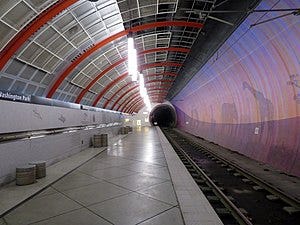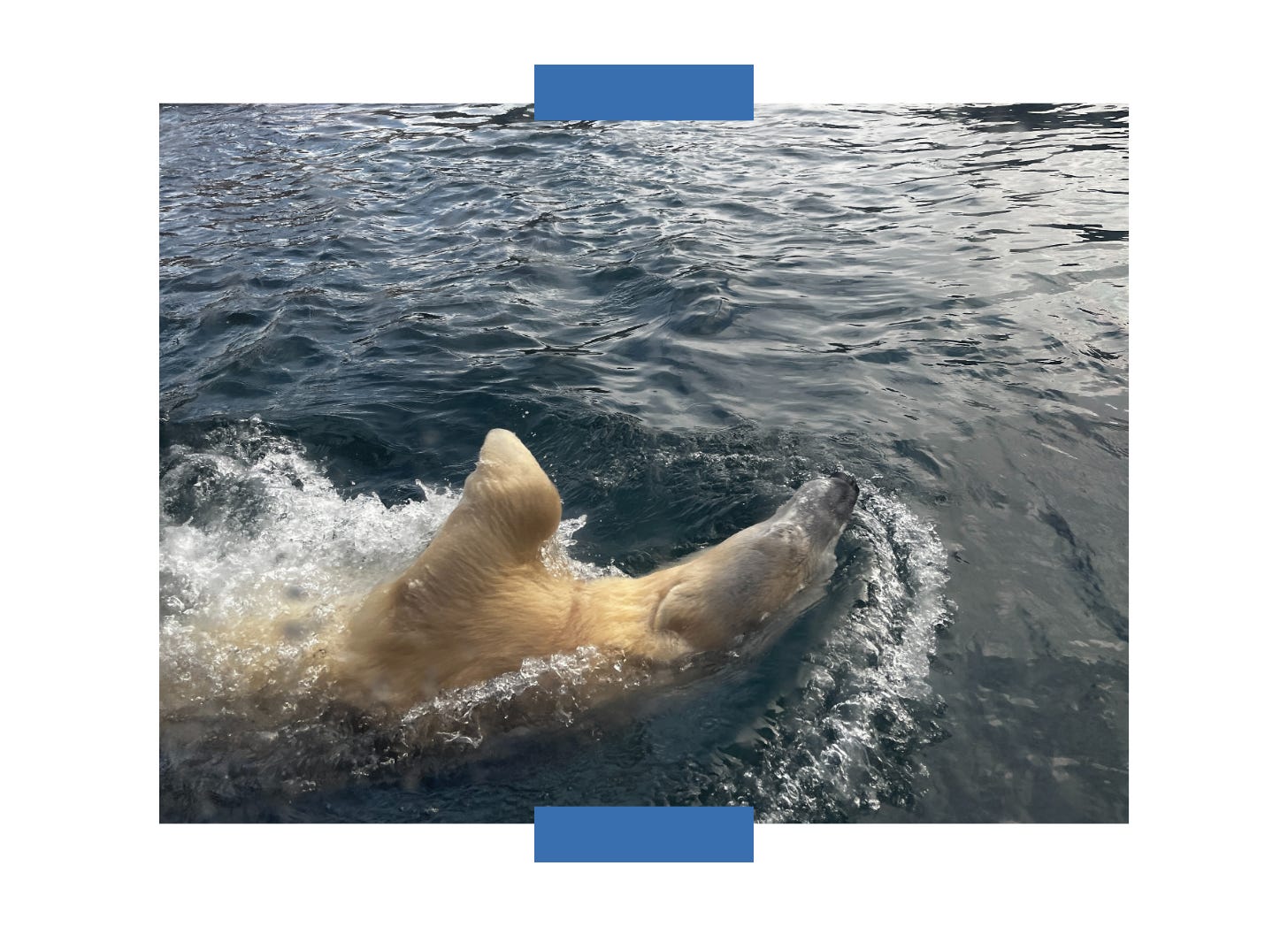Welcome! This is the Going Out edition of Riley’s Recs, where I review a restaurant, bar, or activity here in Portland. Every Sunday, I also share Staying In recipe recommendations for your week. Don’t forget to check out pdxrecs.com for even more recommendations and follow RR on Instagram at @rileysrecs. Enjoy!
During our last local election cycle, I voted “Yes” on Measure 26-244 to improve facilities at the Oregon Zoo.
It was a controversial ballot measure. People have lots of opinions about zoos and how to spend tax dollars. But, ultimately, I voted in favor.
Although I believe Metro should focus on things like affordable housing and social services, I also believe that governments need to prioritize projects that are…fun.
And the zoo is pretty fun. I mean, have you ever seen a naked mole rat crawl? Or a tiger yawn? Or a penguin waddle? Have you ever made eye contact with a sea lion?
Tell me: have you seen an elephant roll a log with its trunk?
The zoo, and all of the animals that live there, are fucking incredible. And worth the $28 a year each taxpayer pays to keep it running, in my opinion.
Seemingly, most Portlanders agree with me—the ballot measure passed with 55% of the vote. But consider this the official RR zoo endorsement.
If you’ve been considering a trip to the zoo, now is the time to go. According to a volunteer I spoke with on a recent visit, animals are more comfortable in the January cold than they are in 90-degree summer weather. So go now, go first thing in the morning while the dens are being cleaned and animals are out and about, and I’m sure you’ll have a good time.
Address: 4001 SW Canyon Rd
Parking: $2 an hour plus fees
Hours: check online for updates. As of Jan 2025, open Fri. to Mon., 9:30 a.m. to 4:30 p.m.
Cost of Admission: $26 (Adult) and $21 (Child); buy online in advance here.
Food: Although there are several food carts and cafeterias located on site, take advantage of the generous outside-food-and-drink policy and BYOL.
The zoo is shockingly accessible from downtown. It’s crazy that you can see flamingos and lions five minutes away from an Urban Outfitters.
To get there, either drive and park in the lot or take the Max, which is a tourist attraction in and of itself. Did you know that the Washington Park max stop is the deepest transit station in North America?! That this is what it looks like?!
Once you arrive at the zoo and scan your tickets, signs will direct you towards the Great Northwest section of the campus. I suspect the reason the recommended route starts here is because these are the animals that are most overlooked, but perhaps the most critical to the Oregon Zoo’s identity and legacy.
Take the California Condor, for example. The Oregon Zoo, in partnership with the U.S. Fish and Wildlife Service, is famous for spearheading the revival of this critically endangered species. In the early 1900s, lead poisoning from feeding on animals shot with lead ammunition nearly decimated their population. So much so that the condor was the first species listed under the Endangered Species Act in 1947. Thanks in part to the Oregon Zoo's breeding program, the population has rebounded from a mere 22 to more than 400 today. Tax dollars at work!
This is impressive, absolutely. This is why zoos exist, for sure. But, to be honest, I skip the Great Northwest animals and beeline to the polar bears. The giant, white polar bears that—according to the zoo’s head veterinarian—love iceberg lettuce more than anything in the world, including meat. These massive salad-enjoyers are also graceful swimmers, and I love watching them backstroke through the pool.
I rush to see my favorite animals because I worry about missing something exciting. You never know what’s happening next at the zoo; when an animal will appear or disappear. Leave too soon and you could miss the lion walking right up to the glass. Rush over to a nearby crowd and, by the time you get there, the rhino could have retreated into its den.
It’s giddy. It’s anxiety inducing. It makes you appreciate what’s right in front of you before it’s gone.
The animals may be caged, but between us and them? They call the shots.
This is the part where I tell you a bunch of fun animal facts. Some come from podcasts I’ve listened to or articles I’ve read (linked at the bottom), but most are from my friend Emma who worked at the Oregon Zoo for a long time. RR has her sources…
Did you know?
The Oregon Zoo was founded in 1888, just 41 years after the opening of the world’s very first zoo, the London Zoo, in 1847. It’s the oldest zoo west of the Mississippi River.
All three of the otters that live in Stellar Cove play basketball to help prevent arthritis. They are honorary Blazer’s members.
The Oregon Zoo is home to Packy, the world’s tallest Asian Elephant. With more than 30 elephant calves born in Oregon, the zoo is one of the most successful breeding programs in the world (what’s the secret to “successful” elephant breeding? Do our female elephants have the sexiest trunks?).
A juvenile bald eagle that lived in Forest Park with its mated parents once flew a little too close to the lion enclosure. One of the younger lionesses caught and killed the baby. It had to be reported to US Fish and Wildlife officials, and it took days to remove the carcass from the proud lioness.
Speaking of bald eagles, all of the ones at the Oregon Zoo are missing one eye?
Animals are evolutionarily trained to hide illness and injury, so providing veterinary care is exceedingly difficult.
Sea otters have the densest fur of all animals. Approximately one million hairs per square inch on their body.
Did it work? Are you sold? Are we zoo supporters?
On a recent visit, I was able to catch a glimpse of two-year-old orangutan Jolene and her mom, Kitra. Little baby Jolene is starting to show personality, and a crowd of us watched through the glass window as she teased her mom, climbed over branches, and spun in circles. It was a relatively cold morning, and Kitra sat with a blanket draped over her shoulders as she watched Jolene play.
Kitra looked tired and slightly annoyed. But patient nonetheless. She looked like a mom.
In the chimpanzee exhibit next door, we saw a similar human-like activity: a young monkey picking his nose…and eating it. A child exclaimed “Ew!” and his mom replied, “Do you remember when you used to do that?”
They’re just like us.
It’s normal to anthropomorphize animals. It’s how we feel empathy towards them, and it’s why we go to the zoo.
But empathy can also be the reason people don’t go to the zoo. It’s sad to imagine a different life where elephants could roam for hundreds of miles. Or otters weren’t confined to the same 50-square feet of water.
But the truth is that we’ve made this planet more and more inhospitable for animals. And for that reason, it’s not really a question of wild versus captivity. It’s a question of wild versus extinct. In the absence of fundamental change, zoos are valuable conservation, research, and education assets. And I think that’s pretty cool.
Links and References
Oregon Zoo Veterinarian on Think Out Loud
How sad are the monkeys at the zoo? Search Engine podcast episode
Animal, a New York Times podcast series
If you liked reading this, click the ❤️ button on this post so more people can discover it on Substack!











